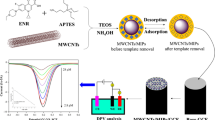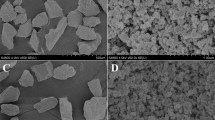Abstract
A kind of new molecularly imprinted polymer (MIP) was synthesized by bulk polymerization using guanosine as dummy template molecule, α-methacrylic acid as functional monomer and ethylene glycol dimethyl acrylic ester as crosslinker. Fourier transform infrared spectroscopy (FT-IR) and scanning electron microscopy (SEM) showed that the MIP had homogenous and uniform-sized cavities. It was confirmed that the MIP had higher binding affinity and selectivity towards gonyautoxins 1,4 (GTX 1,4) than the non-imprinted polymer (NIP) according to the static equilibrium adsorption. An off-line molecularly imprinted solid-phase extraction (MISPE) method followed by high-performance liquid chromatography with fluorescence detection (HPLC-FLD) was established for the analysis of GTX 1,4. 0.1 mol/L acetic acid and 95:5 (v:v) methanol/water were optimized as the washing and elution solutions, respectively. The recoveries of spiked cultured seawater samples were satisfactory, as high as 88 %. Using this method, the concentrations of GTX 1,4 from cultured seawater samples of Alexandrium minutum and Alexandrium tamarense were detected to be 1.10 μg/L and 0.99 μg/L, respectively.

The synthesis of molecularly imprinted polymer and molecularly imprinted solid-phase extraction analysis for gonyautoxin 1,4





Similar content being viewed by others
References
Zhou M-J, Li J. Advances in research of phycotoxins. Chin J Mar Drug. 1999;18(3):48–54.
Asakawa M, Miyazawa K, Takayama H, Noguchi T. Dinoflagellate Alexandrium tamarense as the source of paralytic shellfish poison (PSP) contained in bivalves from Hiroshima Bay, Hiroshima Prefecture. Jap Toxicon. 1995;33(5):691–7.
Lim PT, Ogata T. Salinity effect on growth and toxin production of four tropical Alexandrium species (Dinophyceae). Toxicon. 2005;45(6):699–710.
Vale P, Rangel I, Silva B, Coelho P, Vilar A. A typical profiles of paralytic shellfish poisoning toxins in shellfish from Luanda and Mussulo bays. Angola Toxicon. 2009;53(1):176–83.
Hakanen P, Suikkanen S, Franzén J, Franzén H, Kankaanpӓӓ H, Kremp A. Bloom and toxin dynamics of Alexandrium ostenfeldii in a shallow embayment at the SW coast of Finland, northern Baltic Sea. Harmful Algae. 2012;15:91–9.
Zhou M, Li J, Luckas B, Yu R-C, Yan T, Hummert C, et al. A recent shellfish toxin investigation in China. Mar Pollut Bull. 1999;39(1):331–4.
de Carvalho M, Jacinto J, Ramos N, Oliveira V, Melo T, Sá J. Paralytic shellfish poisoning: clinical and electrophysiological observations. J Neurol. 1998;245(8):551–4.
Benton BJ, Keller SA, Spriggs DL, Capacio BR, Chang FCT. Recovery from the lethal effects of saxitoxin: a therapeutic window for 4-aminopyridine (4-AP). Toxicon. 1998;36(4):571–88.
Hu H-Y, Tang J-L, Wang Y-M, Huang B, Chen Y-H, Mao H-Y. Study on paralytic shellfish poisoning in harmful red tides areas of Zhejiang sea-areas. Environ Poll Contrl. 2006;27(6):470–2.
Velez P, Sierralta J, Alcayaga C, Fonseca M, Loyola H, Johns DC, et al. A functional assay for paralytic shellfish toxins that uses recombinant sodium channels. Toxicon. 2001;39(7):929–35.
Zhang W, J W, Su Y-Q. Enzyme-linked immunosorbent assay (ELISA) quantitative analysis for paralytic shellfish poison (PSP) in shellfish. Marin Sci. 2005;29(6):35–7.
Usleber E, Dietrich R, Bürk C, Schneider E, Martlbӓuer E. Immunoassay methods for paralytic shellfish poisoning toxins. J AOAC Int. 2001;84(5):1649–56.
Locke SJ, Thibault P. Improvement in detection limits for the determination of paralytic shellfish poisoning toxins in shellfish tissues using capillary electrophoresis/electrospray mass spectrometry and discontinuous buffer systems. Anal Chem. 1994;66(20):3436–46.
Dell’Aversano C, Hess P, Quilliam MA. Hydrophilic interaction liquid chromatography–mass spectrometry for the analysis of paralytic shellfish poisoning (PSP) toxins. J Chromatogr A. 2005;1081(2):190–201.
He H-Z, Li H-B, Jiang Y, Chen F. Determination of paralytic shellfish poisoning toxins in cultured microalgae by high-performance liquid chromatography with fluorescence detection. Anal Bioanal Chem. 2005;383(6):1014–7.
Lawrence JF, Niedzwiadek B, Menard C. Quantitative determination of paralytic shellfish poisoning toxins in shellfish using prechromatographic oxidation and liquid chromatography with fluorescence detection: collaborative study. J AOAC Int. 2005;88(6):1714–32.
Oshima Y. Postcolumn derivatization liquid chromatographic method for paralytic shellfish toxins. J AOAC Int. 1995;78(2):528–32.
Chen L-X, Xu S-F, Li J-H. Recent advances in molecular imprinting technology: current status, challenges and highlighted applications. Chem Soc Rev. 2011;40:2922–42.
Chen L-X, Wang X-Y, Lu W-H, Wu X-Q, Li J-H. Molecular imprinting: perspectives and applications. Chem Soc Rev. 2016;45(8):2137–211.
Wen Y-Y, Chen L, Li J-H, Liu D-Y, Chen L-X. Recent advances in solid-phase sorbents for sample preparation prior to chromatographic analysis. TrAC Trends Anal Chem. 2014;59:26–41.
Wen Y-Y, Li J-H, Liu J-S, Lu W-H, Ma J-P, Chen L-X. Dual cloud point extraction coupled with hydrodynamic-electrokinetic two-step injection followed by micellar electrokinetic chromatography for simultaneous determination of trace phenolic estrogens in water samples. Anal Bioanal Chem. 2013;405(17):5843–52.
He X-P, Mei X-Q, Wang J-T, Lian Z-R, Tan L-J, Wu W. Determination of diethylstilbestrol in seawater by molecularly imprinted solid-phase extraction coupled with high-performance liquid chromatography. Mar Pollut Bull. 2016;102:142–7.
He X-P, Tan L-J, Wu W, Wang J-T. Determination of sulfadiazine in eggs using molecularly imprinted solid-phase extraction coupled with high-performance liquid chromatography. J Sep Sci. 2016. doi:10.1002/jssc.201600233.
Lian Z-R, Wang J-T. Study of molecularly imprinted solid-phase extraction of gonyautoxins 2,3 in the cultured dinoflagellate Alexandrium tamarense by high-performance liquid chromatography with fluorescence detection. Environ Pollut. 2013;182:385–91.
Zhang S-w, Gao Y-H. Determination of guanosine in chinese traditional patent medicine with solid phase microextraction by molecularly imprinted monolith. Chin J Anal Lab. 2012;31(9):106–9.
Lian Z-R. Isolation and determination of marine organic pollutants and paralytic shellfish poisoning toxins based on molecularly imprinted solid-phase extraction. Qingdao: Ocean University of China; 2013.
Rodríguez P, Alfonso A, Botana AM, Vieytes MR, Botana LM. Comparative analysis of pre-and post-column oxidation methods for detection of paralytic shellfish toxins. Toxicon. 2010;56(3):448–57.
Acknowledgments
This work was supported by National Programme on Global Change and Air-Sea Interaction under Grant number GASI-03-01-02-01 and the Public Science and Technology Research Funds Projects of Ocean under Grant number 201505034.
Author information
Authors and Affiliations
Corresponding author
Ethics declarations
Conflict of interest
The authors declare that they have no conflict of interest
Rights and permissions
About this article
Cite this article
Mei, XQ., He, XP. & Wang, JT. Molecularly imprinted polymer as efficient sorbent of solid-phase extraction for determination of gonyautoxin 1,4 in seawater followed by high-performance liquid chromatography-fluorescence detection. Anal Bioanal Chem 408, 5737–5743 (2016). https://doi.org/10.1007/s00216-016-9675-9
Received:
Revised:
Accepted:
Published:
Issue Date:
DOI: https://doi.org/10.1007/s00216-016-9675-9




